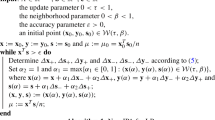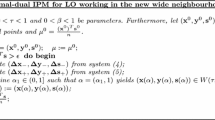Abstract
The layered-step interior-point algorithm was introduced by Vavasis and Ye. The algorithm accelerates the path following interior-point algorithm and its arithmetic complexity depends only on the coefficient matrixA. The main drawback of the algorithm is the use of an unknown big constant\(\bar \chi _A \) in computing the search direction and to initiate the algorithm. We propose a modified layered-step interior-point algorithm which does not use the big constant in computing the search direction. The constant is required only for initialization when a well-centered feasible solution is not available, and it is not required if an upper bound on the norm of a primal—dual optimal solution is known in advance. The complexity of the simplified algorithm is the same as that of Vavasis and Ye. © 1998 The Mathematical Programming Society, Inc. Published by Elsevier Science B.V.
Similar content being viewed by others
References
N. Karmarkar, A new polynomial-time algorithm for linear programming, Combinatorica 4 (1984) 373–395.
S. Vavasis, Y. Ye, A primal-dual accelerated interior point method whose running time depends only onA, Mathematical Programming 74 (1996) 79–120.
É. Tardos, A strongly polynomial algorithm to solve combinatorial linear programs, Operations Research 34 (1986) 250–256.
M. Kojima, S. Mizuno, A. Yoshise, A polynomial-time algorithm for a class of linear complementary problems, Mathematical Programming 44 (1989) 1–26.
R.D.C. Monteiro, I. Adler, Interior path following primal-dual algorithms. Part I: Linear programming, Mathematical Programming 44 (1989) 27–41.
S. Mizuno, M.J. Todd, Y. Ye, On adaptive-step primal-dual interior-point algorithms for linear programming, Mathematics of Operations Research 18 (1993) 964–981.
I.I. Dikin, V.I. Zorkalcev, Iterative Solution of Mathematical Programming Problems: Algorithms for the Method of Interior Points (in Russian), Nauka, Novosibirsk, USSR, 1980.
R.J. Vanderbei, J.C. Lagarias, I.I. Dikin's convergence result for the affine-scaling algorithm, Contemporary Mathematics 114 (1990) 109–119.
M.J. Todd, A Dantzig-Wolfe-like variant of Karmarkar's interior-point linear programming algorithm, Operations Research 38 (1990) 1006–1018.
G.W. Stewart, On scaled projections and pseudoinverses, Linear Algebra and its Applications 112 (1989) 189–193.
S. Vavasis, Y. Ye, A simplification to a primal—dual interior point method whose running time depends only on the constaint matrix, Technical Note, Department of Management Science, University of Iowa, Iowa City (1997).
S. Mizuno, N. Megiddo, T. Tsuchiya, A linear programming instance with many crossover events, Journal of Complexity 12 (1996) 474–479.
T. Tsuchiya, Global convergence property of the affine scaling method for primal degenerate linear programming problems, Mathematics of Operations Research 17 (1992) 527–557.
J.M. Bennett, Triangular factors of modified matrices, Numerische Mathematik 7 (1965) 217–221.
P.E. Gill, G.H. Golub, W. Murray, M.A. Saunders, Methods for modifying matrix factorization, Mathematics of Computation 28 (1974) 505–535.
Author information
Authors and Affiliations
Additional information
Research supported in part by ONR contract N00014-94-C-0007 and the Grant-in-Aid for Scientific Research (C) 08680478 and the Grant-in-Aid for Encouragement of Young Scientists (A) 08780227 of the Ministry of Science, Education and Culture of Japan. This research was partially done while S. Mizuno and T. Tsuchiya were visiting IBM Almaden Research Center in the summer of 1995.
Rights and permissions
About this article
Cite this article
Megiddo, N., Mizuno, S. & Tsuchiya, T. A modified layered-step interior-point algorithm for linear programming. Mathematical Programming 82, 339–355 (1998). https://doi.org/10.1007/BF01580074
Received:
Revised:
Issue Date:
DOI: https://doi.org/10.1007/BF01580074




